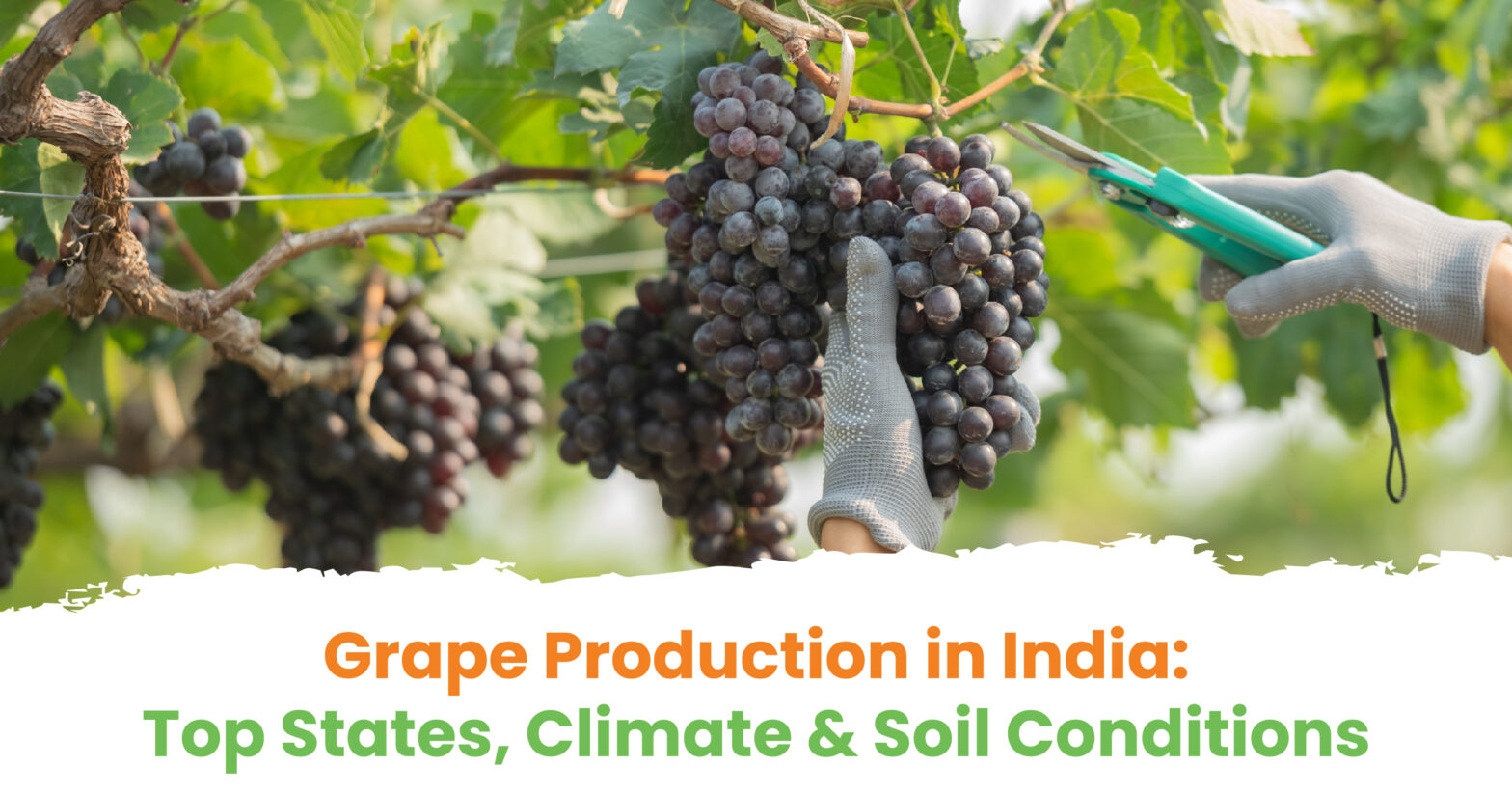
Grape production in India is a significant agricultural activity, with the country being one of the top producers of grapes in the world.
India’s grape production is not only important for domestic consumption but also for exports. Indian grapes are exported to countries in the Middle East, Europe, and South-East Asia, making it an important crop for foreign exchange earnings.
Types of Grapes Grown in India
- Table Grapes: These are grapes meant for direct consumption. Varieties include Thompson Seedless, Flame Seedless, and Sharad Seedless.
- Wine Grapes: Used for winemaking, with prominent varieties like Cabernet Sauvignon, Shiraz, and Sauvignon Blanc.
- Raisin Grapes: Grapes grown for drying into raisins, mainly produced in Maharashtra.
Must Read: Optimizing Farming Efficiency: Rotavator Uses in Agriculture
History of Grape Production in India
India’s history of grape production has evolved significantly over the centuries, particularly in the last few decades.
Grapes were believed to have been introduced to India by Persian and Greek traders around 1300 BCE. Early references to grapes can be found in ancient Indian texts, indicating the presence of grapevines in the northwestern regions of the Indian subcontinent.
During British colonial rule, commercial grape cultivation was promoted in some regions.
After India’s independence, grape production in India expanded significantly. The government began to promote agricultural diversification. In the 1960s and 1970s, research institutions like the National Research Centre for Grapes (NRCG) in Pune were established to support the industry with modern techniques. From the late 1980s onwards, India began to produce grapes for export, especially to markets in Europe, Southeast Asia, and the Middle East.
India has seen a surge in winemaking since the 2000s, especially in regions like Nashik, Maharashtra, often referred to as the “Wine Capital of India.” Today, India is among the largest producers of grapes in the world. Maharashtra alone contributes nearly 80% of the country’s grape production. Both table grapes and wine grapes are grown, with a large portion of the production aimed at export.
In recent years, Indian grape farmers have started to adopt more sustainable and organic farming practices to meet global standards and increasing demand for pesticide-free produce.
Good Weather for Grape Production in India
Grape production in India thrives under specific climatic conditions. Here are the key factors that contribute to good weather for cultivation of grapes:
- Temperature: Grapes require a warm climate. The ideal temperature for grape growth is between 20°C to 30°C (68°F to 86°F). A higher temperature during the ripening phase can enhance sugar accumulation.
- Sunshine: Grapes need plenty of sunlight for at least 8 hours a day. Regions with abundant sunlight help in the development of flavor and sugar content in the grapes.
- Rainfall: Grapes prefer a well-drained soil and do not thrive in excessive moisture. While they require water during the initial growth stages, too much rainfall, especially during the harvest season, can lead to disease and rot. Ideally, annual rainfall should be between 500 mm to 800 mm.
- Humidity: Grapes grow best in moderate humidity levels. High humidity can lead to fungal diseases, while very low humidity can stress the plants.
- Soil: Well-drained, sandy loam or loamy soil with good organic content is ideal for grape cultivation. The soil pH should be slightly acidic to neutral (between 6.0 to 7.0).
Also Read: Rice Cultivation in India: Key Equipment for Land Preparation
Soil Conditions for Grapes in India
In India, cultivation of grapes is highly influenced by soil conditions. Here are the ideal soil conditions for growing grapes in India:
- Soil Type: Grapes grow best in well-drained, sandy loam to clay loam soils. The soil should be loose and porous to allow proper root penetration and water drainage.
- Soil pH: The ideal soil pH for grapes is between 6.5 and 7.5. Slightly alkaline soils are preferred. Highly acidic or saline soils can affect vine growth and grape quality.
- Water Retention: Grapes farming require moderate water retention in the soil. Excess water retention leads to waterlogging, which can cause root rot, while very sandy soils that drain too quickly may need frequent irrigation.
- Nutrient-Rich Soil: The soil should be rich in organic matter. Nutrients like potassium, nitrogen, and phosphorous are important for healthy vine growth and fruit production. Fertilization may be needed to maintain optimal nutrient levels.
- Depth of Soil: Deep soils (at least 1 to 1.5 meters) are preferred to support the root system and allow for better water and nutrient absorption.
- Climate Considerations: Grapes farming is convenient in areas with a hot and dry climate. Regions like Maharashtra, Karnataka, Tamil Nadu, and Andhra Pradesh are well-known for cultivation of grapes, with soils and climates well-suited for the crop.
States Producing Grapes in India
India is one of the major producers of grapes, and several states contribute significantly to its grape production. The key grape-producing states in India are:
Maharashtra
- Maharashtra is the largest grape-producing state in India, accounting for around 80% of the country’s total grape production. Major regions include Nashik, Sangli, Pune, and Solapur.
Karnataka
- Karnataka is the second-largest grape producer, with regions like Bijapur and Bagalkot being key areas for grape cultivation.
Tamil Nadu
- Tamil Nadu produces grapes, particularly in areas like Coimbatore, Dindigul, and Theni.
Andhra Pradesh
- Regions like Chittoor and Anantapur in Andhra Pradesh are also known for grape cultivation.
Telangana
- The state produces grapes mainly in the Medak and Nalgonda districts.
Punjab
- Though not as prominent as Maharashtra or Karnataka, Punjab also contributes to grape production in regions like Ludhiana and Hoshiarpur.
Haryana
- Some regions in Haryana, particularly in the southern parts, have vineyards that contribute to the grape output.
Uttar Pradesh
- Small-scale grape production is also seen in Uttar Pradesh, especially in regions like Saharanpur.
CONCLUSION
Grapes are typically planted in early spring and harvested in late summer to early fall, depending on the variety. A combination of warm temperatures, ample sunshine, moderate rainfall, and well-drained soil contribute to successful grape production in India. Maintaining proper soil health with organic matter, good drainage, and balanced nutrients is crucial for successful grape cultivation in India.


 Admin
Admin 

